Five decades ago Japan was considered nothing short of a miracle. Lacking substantial natural resources and emerging from the ruins of the Second World War, Japan made economic strides purely through ingenuity and industriousness.
As the small Pacific country raced ahead in myriad industries such as electronics, steel making, and automobiles, it was crowned a high-tech champion.
Armed with cash and technology, Japanese companies set out in droves to all corners of the world looking for investment opportunities. For a time, it looked like Japan would buy the world outright even as the rest of the globe viewed the small island with envy.
Fast-forward to today. Japan is still in the spotlight – but for all the wrong reasons. The once high-achieving nation full of vigor is now getting disgracefully low scores for its economic performance. Japan’s nominal GDP in 2012 is roughly at the same level as it was in 1990.
Ever since the real-estate crash of the 1990’s, Japan’s economic growth has come in fits and starts. Analysts have practically lost count of the number of technical recessions that Japan has experienced over the past two decades.
Some economists are confounded how a nation that once offered best-of-breed products could take a path of ever-shrinking output. Many of Japan’s corporate giants of the past have now been reduced to also-rans.
What May be Wrong with Japan?
Experts attribute Japan’s economic decline to a number of factors ranging from changing demographics to rigid corporate structure, and cynical politics to hapless monetary policy. They opine that the potent combination of these factors now undermine Japan’s economic facade built over decades of hard work. Time and again Japan’s politicians have fumbled to come to terms with their country’s economic problems. In fact, Japan has had six prime ministers over the past five years, all trying in vain to root out well-entrenched economic challenges.
In Comes Mr. Abe
The world was waiting for something radical to emerge out of Japan to change the economic course of a nation in deep slumber. And that came in the form of Shinzo Abe, Japan’s newly elected prime minister. Mr. Abe, who came to power in December 2012, started his election campaign by attacking Japan’s central bank – widely regarded as an unusual thing to do.
Mr. Abe thinks he has good reasons to do so. Japan’s central bank, the Bank of Japan (BOJ), has had a dismal record in meeting its inflation target over the past 15 years. For a substantial period in the past decade, Japan has suffered a mild, yet persistent, deflation.
Many economists dread deflation more than inflation. In their view deflationary expectations create a vicious cycle resulting in the erosion of economic activity.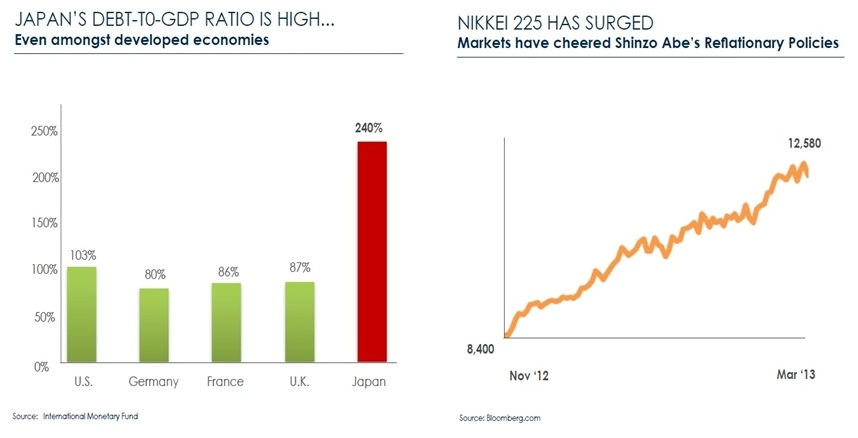
Japanese central bankers have been unable to break the deflationary cycle that has weighed on the country’s output.
This has irked Japan’s newly-elected prime minister. Mr. Abe did not hide his impatience with Japan’s current leadership at the central bank even on the election trail. True to his intentions, soon after winning a strong mandate from the electorate in late 2012, Mr. Abe announced his own set of central bankers to carry out his economic policies.
“Abenomics”
In February, Mr. Abe nominated three ‘reflationary’ economists to the Bank of Japan, including one for the governor of the central bank. In Japan’s media-speak, reflationary economics refers to the kindling of inflation through aggressive monetary easing by bond-buying and other widely viewed unorthodox measures. In recent times such radical policies were pursued by the U.S. and the European Union to steer their economies away from the cliff.
To be sure, Japan is not new to bond-buying as a central banking practice. In fact, the country pioneered the move ever since it ran out of conventional tools to fight deflation some 15 years ago. However, it was the magnitude of bond-buying by Japan’s central bank that has come under question. While the U.S. poured trillions of dollars into the bond market to stimulate the economy, Japan’s monetary easing has always looked timid.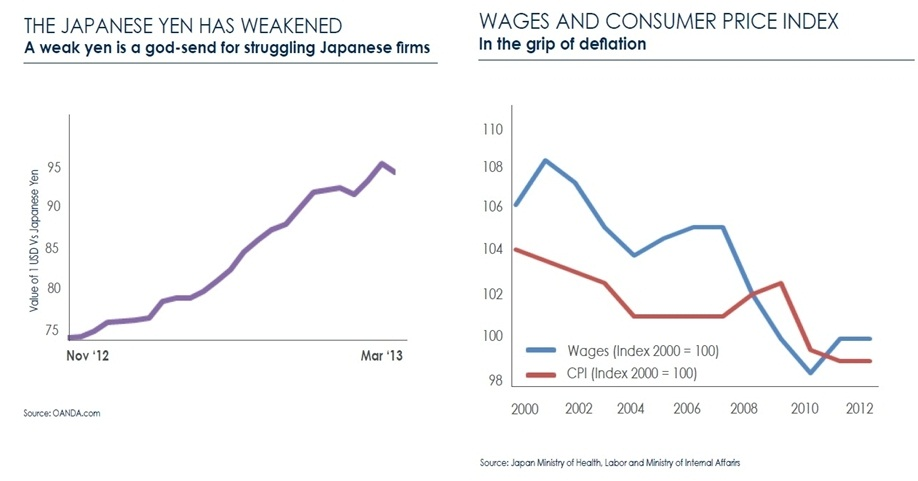
However, Mr. Abe would have no more of the BOJ’s half-hearted monetary policy. By threatening to change the law governing the central bank, and by extension, its independence, Mr. Abe signalled his seriousness over Japan’s monetary policy.
Financial markets gave their thumbs-up to Mr Abe. In the two months after his election, Japan’s Topix stock index jumped 22 percent and the yen, whose weakness helps the competitiveness of Japanese exporters like Sony and Toyota, went on a free fall. Mr Abe’s popularity rate at home soared, touching 70 percent in Japan.
To make the monetary policy potent, Mr. Abe combined it with a fiscal stimulus to the tune of nearly 10.3 trillion yen ($116 billion). The government claims that the fiscal stimulus will help boost Japan’s GDP by 2 percent and create 600,000 jobs. Mr. Abe has had some success in getting the international community’s support for his brave new policies. But will they actually turn out to be the elixir that a comatose Japan needs?
A mountain of challenges awaits Mr. Abe as he takes on some age-old habits of Japan.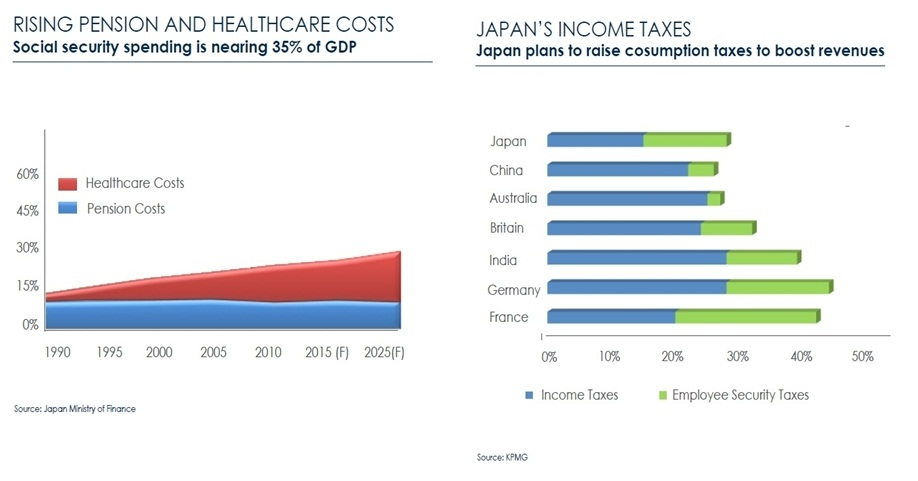
Face It Mr. Abe
The monetary issue that Japan is now faced with is just the tip of the iceberg. Much of Japan’s problems are structural and they seek Mr. Abe’s unwavering attention. In the absence of two decades of robust growth and consumer spending, Japan’s government was left with the responsibility of keeping the economy afloat. The Japanese government embarked on a number of big-ticket construction spending projects with the idea of stimulating the economy and generating jobs.
While the debt-financed construction boom did generate jobs and partially made up for the absence of private investment and spending, Japan’s debt has soared immensely over the past two decades. Japan’ debt-to-GDP ratio of 240 percent is the highest in the world. In contrast, the U.S. has a debt-to-GDP of 100 percent.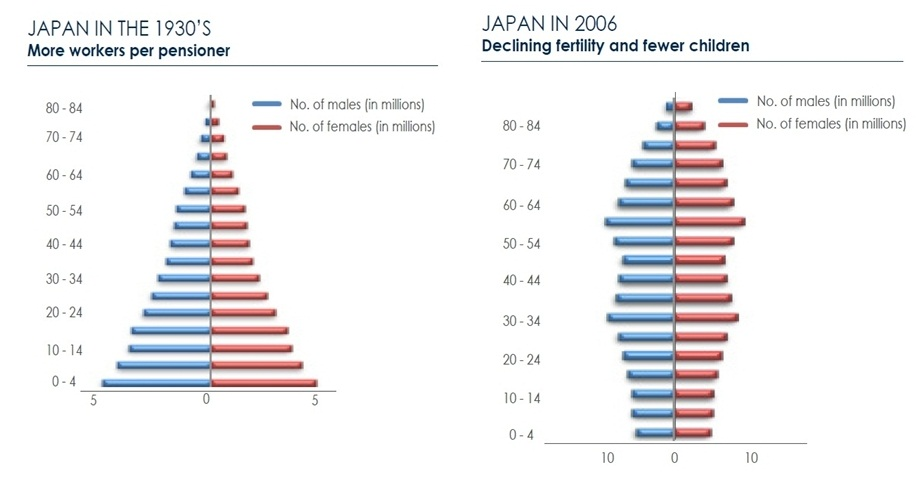
With each incremental amount of debt in Japan progressively delivering little in the form of growth or jobs, the Japanese government is faced with the unenviable task of managing a tough set of finances. Mr. Abe’s current fiscal stimulus could still further add to the country’s rising pile of debt before helping the economy.
Mr Abe is now faced with the delicate task of raising Japan’s sales tax to address the country’s debt. While Abe’s Liberal Democratic Party supported increasing the sales tax to 8 percent in 2014 and then to 10 percent in 2015, now that Mr. Abe is in power he is hesitant to implement the tax proposal.
Laboring in the labor Market
Further, at the root of Japan’s many economic problems lie some uncomfortable truths. Japan simply does not have enough hands to work its economy and sustain itself at the top of the world economic order. Some economists trace the reason why Japan lost the position of the world’s second largest economy to China a few years back to the country’s declining population.
While a declining population is a major problem across the developed world, Japan’s issue with its population is acute. The population in many OECD countries has been growing at a snail’s pace but Japan’s population has actually been shrinking. From a peak of 128 million in 2005, Japan’s population has shriveled in each of the past seven years.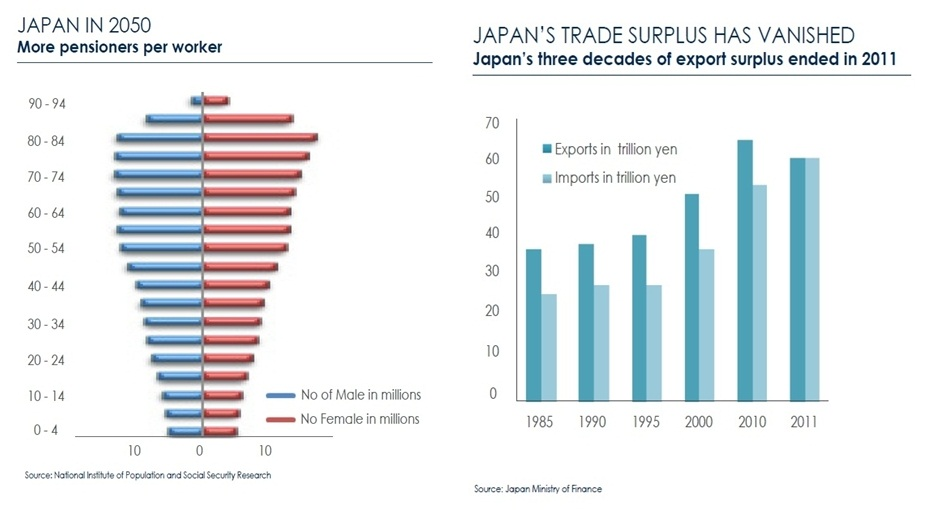
With its birth rate falling and life expectancy rising, Japan has a skewed dependency ratio – the number of people over 65 years and children versus the number of people in the working age of 15 and 64.
As Japan’s aging population increased so did the amount of money spent on pensions, medical expenses, and social security. Back in the 1960’s for every Japanese pensioner there were 11 workers in the labor force paying taxes but now for every one Japanese pensioner there are just 2.6 workers. The working age population has been shrinking every year since 1996.
Economists also trace the reasons for Japan’s deflation to the country’s dwindling workforce. Normally, in any given country, the biggest spenders fall in the demographic group representing those between 15 and 64 years of age. With this group declining in number for nearly 15 years in Japan, consumption has been persistently weak. What’s more, the Japanese labor market offers a raw deal to a young worker.
Thus far, many Japanese firms have survived the country’s deflation by exporting more and cutting costs at home. A substantial part of cost-cuts have fallen on Japanese workers.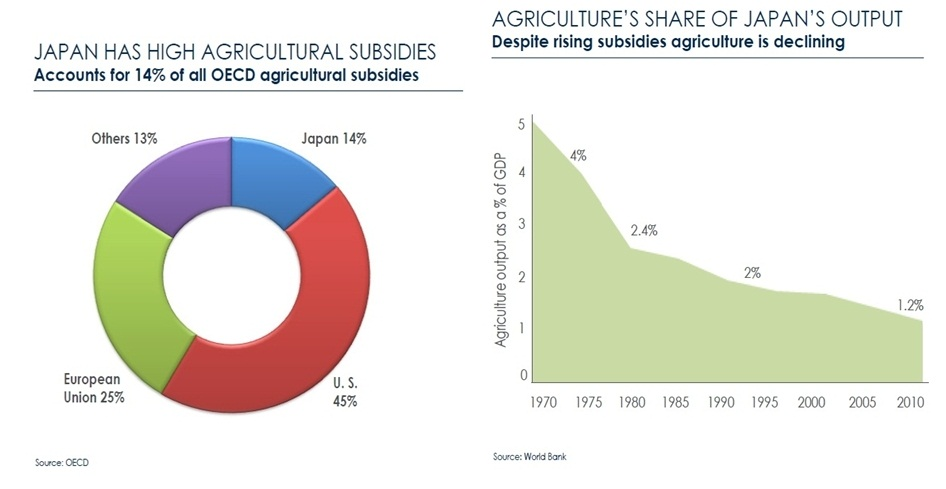
Hiring trends from Japanese firms too have undergone a sea change over the years. The share of non-regular workers, who typically have lower pay and less robust job guarantees, has jumped to over 34 percent in 2010 from 16 percent in 1985. Without strong social support, workers are hesitant to loosen their purse strings leading to lukewarm consumption and persisting deflation.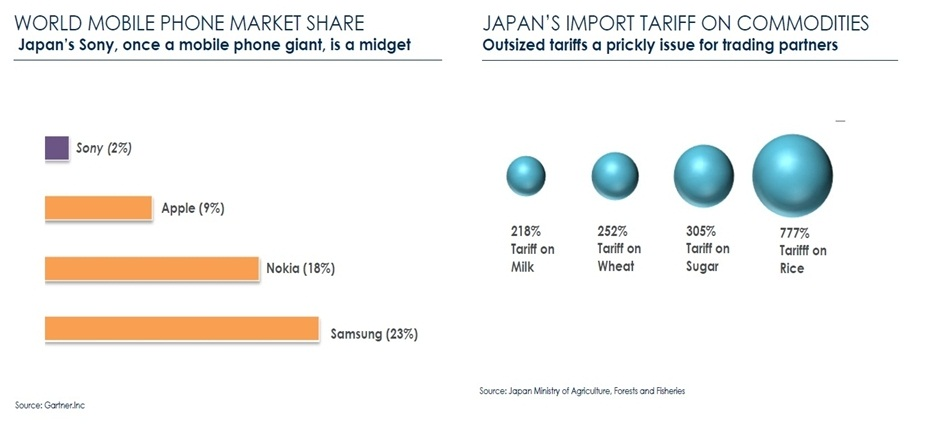
Given this scenario, Mr. Abe is now faced with two options to increase Japan’s output. Either make the existing workforce more productive or increase the size of the workforce by letting in immigrants. Letting in immigrants has long been an anathema to Japan. So, Mr. Abe, after imploring the country’s businesses to boost wages, is now focusing on indirectly improving the productivity in the country. Again he has ruffled some powerful interests within his own party to give a new lease on life to some prudent but long-forgotten economic policies.
Embracing the Trans-Pacific Partnership
The year 2011 marked a crossroads for Japanese merchandise trade. It was also a year that proud Japanese exporters would rather not be mentioned. After a gap of nearly 50 years, Japan bought more goods from the outside world than it had sold to foreigners. An even bigger $18 billion trade deficit followed in 2012. Japanese exporters blamed the yen, which has strengthened over the past five years, as their problem. But many economists reckon that Japan is facing a competitiveness issue at a deeper level. These days Samsung and Hyundai from South Korea are giving the Japan-based Sony and Toyota a run for their money.
Furthermore, while the most innovative companies across the world have been quick to exploit the high-margin potential of the software and services industry, Japanese companies have largely struck to the highly competitive and relatively less-profitable manufacturing industry.
Mr. Abe however intends to instill more vigor in Japan by opening the country to more competition and investment from abroad.
While Japan engaged in erecting barriers to preserve its domestic constituencies, neighboring South Korea quickly negotiated free trade treaties with a dozen countries and stole the thunder from Japanese exports.
Trade for Good
Mr. Abe certainly understands the importance of free trade. Just after jolting the monetary establishment of Japan, Mr. Abe announced his intentions for Japan to join the negotiations for the Trans-Pacific Partnership (TPP), a free trade agreement that will facilitate free movement of goods and services without tariffs and includes countries such as the U.S., Australia, and Singapore as partners.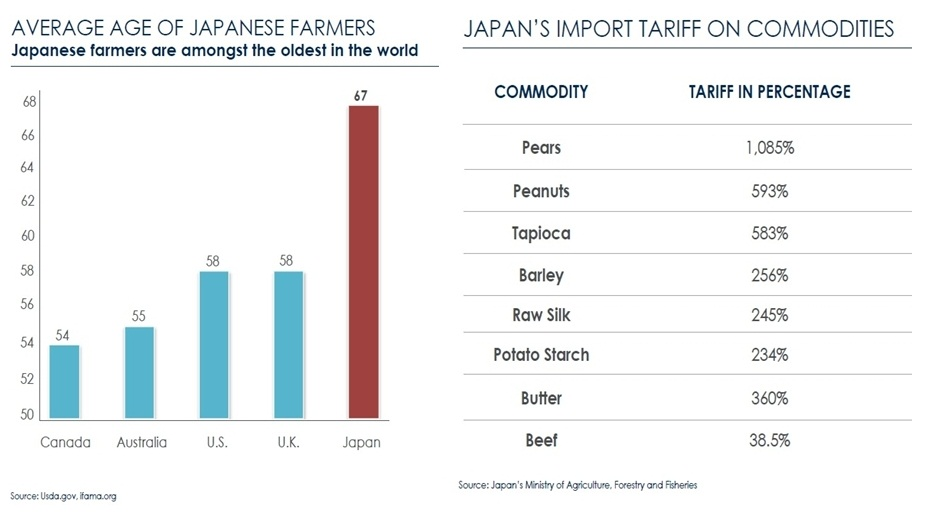
But that is easier said than done. Japan’s agriculture is heavily subsidized. In fact, Japan’s rice cultivation is only made profitable by slapping a tariff of 777.7 percent on imported rice. If Japan joins the TPP, there may be pressure on the country to remove the rice tariffs that currently sustain Japanese agriculture. But Japanese farmers are a vocal lot, and are quick to show their displeasure on Election Day. They typically vote for the conservative party that Mr. Abe currently heads.
If Mr. Abe insists that Japan join the TPP he risks losing support of some of his long-time loyalists. Nonetheless, if current indicators suggest that Mr. Abe will sustain his maverick course, then perhaps getting Japan on the TPP bandwagon is not a mere dream.
High Risk Gamble Yet the Need-of-the-Hour?
Many economists opine that Mr. Abe’s policies are 15-years too late. While they appreciate Mr. Abe’s trade policies, they consider his stand on immigration still too opaque. It is widely perceived that Mr Abe’s monetary and fiscal policies are a huge gamble. At best they can create the room needed for Japan to pursue other reforms, by breaking the country’s deflationary expectations. But if they go wrong, they could push Japan deeper into debt, create asset bubbles elsewhere, and provoke retaliatory currency policies from other countries.
Nonetheless, the international community, especially the West, understands that Japan’s problems have not been the result of a single misstep and they certainly do not expect Japan’s economic problems solved overnight. They have credited Mr. Abe for his policies thus far and are encouraging him from the side lines.
In an energetic speech in the U.S. in early 2013, Mr. Abe declared “Japan is back”. Now, it is time for Japan to live up to Mr. Abe’s expectations.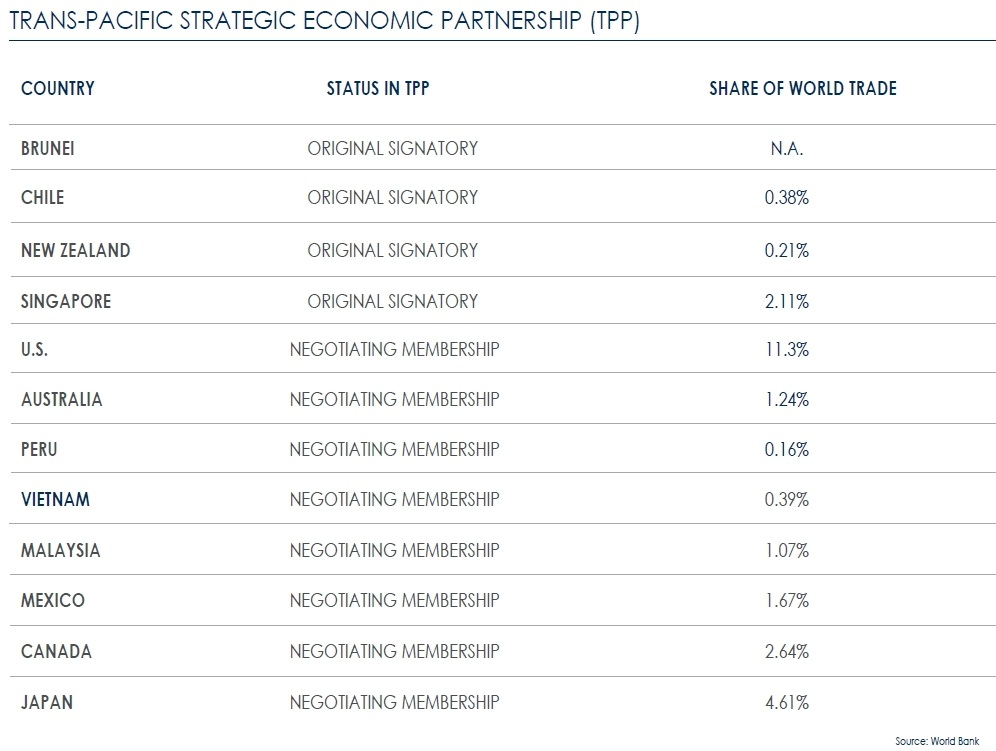
This article is for informational purposes only. This article is not intended to provide tax, legal, insurance or other investment advice. Unless otherwise specified, you are solely responsible for determining whether any investment, security or other product or service is appropriate for you based on your personal investment objectives and financial situation. You should consult an attorney or tax professional regarding your specific legal or tax situation. The information contained in this article does not, in any way, constitute investment advice and should not be considered a recommendation to buy or sell any security discussed herein. It should not be assumed that any investment will be profitable or will equal the performance of any security mentioned herein. Thomas White International, Ltd, may, from time to time, have a position or interest in, or may buy, sell or otherwise transact in, or with respect to, a particular security, issuer or market on our own behalf or on behalf of a client account.
FORWARD LOOKING STATEMENTS
Certain statements made in this article may be forward looking. Actual future results or occurrences may differ significantly from those anticipated in any forward looking statements due to numerous factors. Thomas White International, Ltd. undertakes no responsibility to update publicly or revise any forward looking statements.
BY Thomas White
- English (UK)
- English (India)
- English (Canada)
- English (Australia)
- English (South Africa)
- English (Philippines)
- English (Nigeria)
- Deutsch
- Español (España)
- Español (México)
- Français
- Italiano
- Nederlands
- Português (Portugal)
- Polski
- Português (Brasil)
- Русский
- Türkçe
- العربية
- Ελληνικά
- Svenska
- Suomi
- עברית
- 日本語
- 한국어
- 简体中文
- 繁體中文
- Bahasa Indonesia
- Bahasa Melayu
- ไทย
- Tiếng Việt
- हिंदी
Will ‘Abenomics’ Ensure Japan’s Revival?
Published 04/25/2013, 06:08 AM
Updated 07/09/2023, 06:31 AM
Will ‘Abenomics’ Ensure Japan’s Revival?
3rd party Ad. Not an offer or recommendation by Investing.com. See disclosure here or
remove ads
.
Latest comments
Install Our App
Risk Disclosure: Trading in financial instruments and/or cryptocurrencies involves high risks including the risk of losing some, or all, of your investment amount, and may not be suitable for all investors. Prices of cryptocurrencies are extremely volatile and may be affected by external factors such as financial, regulatory or political events. Trading on margin increases the financial risks.
Before deciding to trade in financial instrument or cryptocurrencies you should be fully informed of the risks and costs associated with trading the financial markets, carefully consider your investment objectives, level of experience, and risk appetite, and seek professional advice where needed.
Fusion Media would like to remind you that the data contained in this website is not necessarily real-time nor accurate. The data and prices on the website are not necessarily provided by any market or exchange, but may be provided by market makers, and so prices may not be accurate and may differ from the actual price at any given market, meaning prices are indicative and not appropriate for trading purposes. Fusion Media and any provider of the data contained in this website will not accept liability for any loss or damage as a result of your trading, or your reliance on the information contained within this website.
It is prohibited to use, store, reproduce, display, modify, transmit or distribute the data contained in this website without the explicit prior written permission of Fusion Media and/or the data provider. All intellectual property rights are reserved by the providers and/or the exchange providing the data contained in this website.
Fusion Media may be compensated by the advertisers that appear on the website, based on your interaction with the advertisements or advertisers.
Before deciding to trade in financial instrument or cryptocurrencies you should be fully informed of the risks and costs associated with trading the financial markets, carefully consider your investment objectives, level of experience, and risk appetite, and seek professional advice where needed.
Fusion Media would like to remind you that the data contained in this website is not necessarily real-time nor accurate. The data and prices on the website are not necessarily provided by any market or exchange, but may be provided by market makers, and so prices may not be accurate and may differ from the actual price at any given market, meaning prices are indicative and not appropriate for trading purposes. Fusion Media and any provider of the data contained in this website will not accept liability for any loss or damage as a result of your trading, or your reliance on the information contained within this website.
It is prohibited to use, store, reproduce, display, modify, transmit or distribute the data contained in this website without the explicit prior written permission of Fusion Media and/or the data provider. All intellectual property rights are reserved by the providers and/or the exchange providing the data contained in this website.
Fusion Media may be compensated by the advertisers that appear on the website, based on your interaction with the advertisements or advertisers.
© 2007-2024 - Fusion Media Limited. All Rights Reserved.